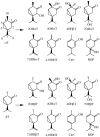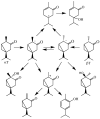Radical intermediates in the catalytic oxidation of hydrocarbons by bacterial and human cytochrome P450 enzymes
- PMID: 16401082
- PMCID: PMC2566308
- DOI: 10.1021/bi051840z
Radical intermediates in the catalytic oxidation of hydrocarbons by bacterial and human cytochrome P450 enzymes
Abstract
Cytochromes P450cam and P450BM3 oxidize alpha- and beta-thujone into multiple products, including 7-hydroxy-alpha-(or beta-)thujone, 7,8-dehydro-alpha-(or beta-)thujone, 4-hydroxy-alpha-(or beta-)thujone, 2-hydroxy-alpha-(or beta-)thujone, 5-hydroxy-5-isopropyl-2-methyl-2-cyclohexen-1-one, 4,10-dehydrothujone, and carvacrol. Quantitative analysis of the 4-hydroxylated isomers and the ring-opened product indicates that the hydroxylation proceeds via a radical mechanism with a radical recombination rate ranging from 0.7 +/- 0.3 x 10(10) s(-1) to 12.5 +/- 3 x 10(10) s(-1) for the trapping of the carbon radical by the iron-bound hydroxyl radical equivalent. 7-[2H]-alpha-Thujone has been synthesized and used to amplify C-4 hydroxylation in situations where uninformative C-7 hydroxylation is the dominant reaction. The involvement of a carbon radical intermediate is confirmed by the observation of inversion of stereochemistry of the methyl-substituted C-4 carbon during the hydroxylation. With an L244A mutation that slightly increases the P450(cam) active-site volume, this inversion is observed in up to 40% of the C-4 hydroxylated products. The oxidation of alpha-thujone by human CYP1A2, CYP2C9, CYP2C19, CYP2D6, CYP2E1, and CYP3A4 occurs with up to 80% C-4 methyl inversion, in agreement with a dominant radical hydroxylation mechanism. Three minor desaturation products are produced, with at least one of them via a cationic pathway. The cation involved is proposed to form by electron abstraction from a radical intermediate. The absence of a solvent deuterium isotope effect on product distribution in the P450cam reaction precludes a significant role for the P450 ferric hydroperoxide intermediate in substrate hydroxylation. The results indicate that carbon hydroxylation is catalyzed exclusively by a P450 ferryl species via radical intermediates whose detailed properties are substrate- and enzyme-dependent.
Figures




Similar articles
-
Radical rebound mechanism in cytochrome P-450-catalyzed hydroxylation of the multifaceted radical clocks alpha- and beta-thujone.J Biol Chem. 2004 Sep 17;279(38):39479-84. doi: 10.1074/jbc.M406838200. Epub 2004 Jul 17. J Biol Chem. 2004. PMID: 15258138
-
Molecular recognition in (+)-alpha-pinene oxidation by cytochrome P450cam.J Am Chem Soc. 2003 Jan 22;125(3):705-14. doi: 10.1021/ja028460a. J Am Chem Soc. 2003. PMID: 12526670
-
Cooperative effects on radical recombination in CYP3A4-catalyzed oxidation of the radical clock beta-thujone.Chembiochem. 2009 Mar 2;10(4):650-3. doi: 10.1002/cbic.200800772. Chembiochem. 2009. PMID: 19189363 Free PMC article.
-
Differential behavior of the sub-sites of cytochrome 450 active site in binding of substrates, and products (implications for coupling/uncoupling).Biochim Biophys Acta. 2007 Mar;1770(3):360-75. doi: 10.1016/j.bbagen.2006.09.018. Epub 2006 Oct 5. Biochim Biophys Acta. 2007. PMID: 17134838 Review.
-
Models and mechanisms of O-O bond activation by cytochrome P450. A critical assessment of the potential role of multiple active intermediates in oxidative catalysis.Eur J Biochem. 2004 Nov;271(22):4335-60. doi: 10.1111/j.1432-1033.2004.04380.x. Eur J Biochem. 2004. PMID: 15560776 Review.
Cited by
-
Formation and Cleavage of C-C Bonds by Enzymatic Oxidation-Reduction Reactions.Chem Rev. 2018 Jul 25;118(14):6573-6655. doi: 10.1021/acs.chemrev.8b00031. Epub 2018 Jun 22. Chem Rev. 2018. PMID: 29932643 Free PMC article. Review.
-
Mechanistic aspects of CYP74 allene oxide synthases and related cytochrome P450 enzymes.Phytochemistry. 2009 Sep;70(13-14):1522-31. doi: 10.1016/j.phytochem.2009.08.005. Epub 2009 Sep 9. Phytochemistry. 2009. PMID: 19747698 Free PMC article. Review.
-
A Review of Ganoderma Triterpenoids and Their Bioactivities.Biomolecules. 2022 Dec 22;13(1):24. doi: 10.3390/biom13010024. Biomolecules. 2022. PMID: 36671409 Free PMC article. Review.
-
Rearrangement reactions catalyzed by cytochrome P450s.Arch Biochem Biophys. 2011 Mar 1;507(1):95-110. doi: 10.1016/j.abb.2010.10.016. Epub 2010 Oct 29. Arch Biochem Biophys. 2011. PMID: 20971058 Free PMC article. Review.
-
Comparative characterization of the lactimidomycin and iso-migrastatin biosynthetic machineries revealing unusual features for acyltransferase-less type I polyketide synthases and providing an opportunity to engineer new analogues.Biochemistry. 2014 Dec 16;53(49):7854-65. doi: 10.1021/bi501396v. Epub 2014 Dec 1. Biochemistry. 2014. PMID: 25405956 Free PMC article.
References
-
- Kagawa N, Waterman MR. Regulation of steroidogenic and related P450s. In: Ortiz de Montellano PR, editor. Cytochrome P450: Structure, Mechanism, and Biochemistry. 2nd Ed. Plenum Press; New York: 1995. pp. 419–442.
-
- Capdevila JH. Cytochrome P450 and the metabolism and bioactivation of arachidonic acid and eicosanoids. In: Ortiz de Montellano PR, editor. Cytochrome P450: Structure, Mechanism, and Biochemistry. 3rd Ed. Plenum Klewer; New York: 2005. pp. 531–551.
-
- Groves JT, McGlusky GA, White RE, Coon MJ. Aliphatic hydroxylation by highly purified liver microsomal cytochrome P450. Evidence for a carbon radical intermediate. Biochem. Biophys. Res. Commun. 1978;81:154–160. - PubMed
-
- Ortiz de Montellano PR, De Voss JJ. Substrate oxidation by cytochrome P450 enzymes. In: Ortiz de Montellano PR, editor. Cytochrome P450: Structure, Mechanism, and Biochemistry. 3rd Ed. Plenum Klewer; New York: 2005. pp. 183–245.
-
- Makris TM, Denisov I, Schlichting I, Sligar SG. Activation of molecular oxygen by cytochrome P450. In: Ortiz de Montellano PR, editor. Cytochrome P450: Structure, Mechanism, and Biochemistry. 3rd Ed. Plenum Klewer; New York: 2005. pp. 149–182.
Publication types
MeSH terms
Substances
Grants and funding
LinkOut - more resources
Full Text Sources
Molecular Biology Databases
Miscellaneous

